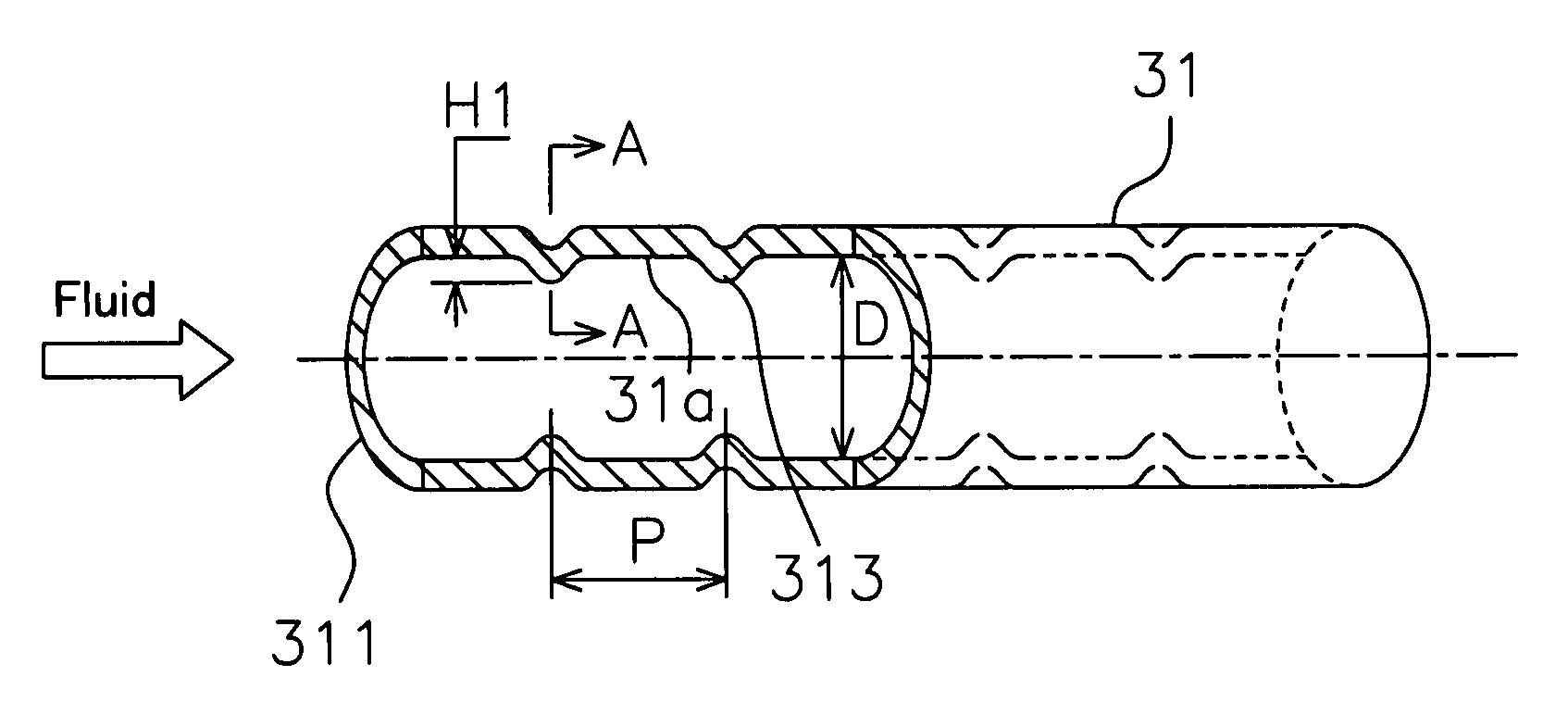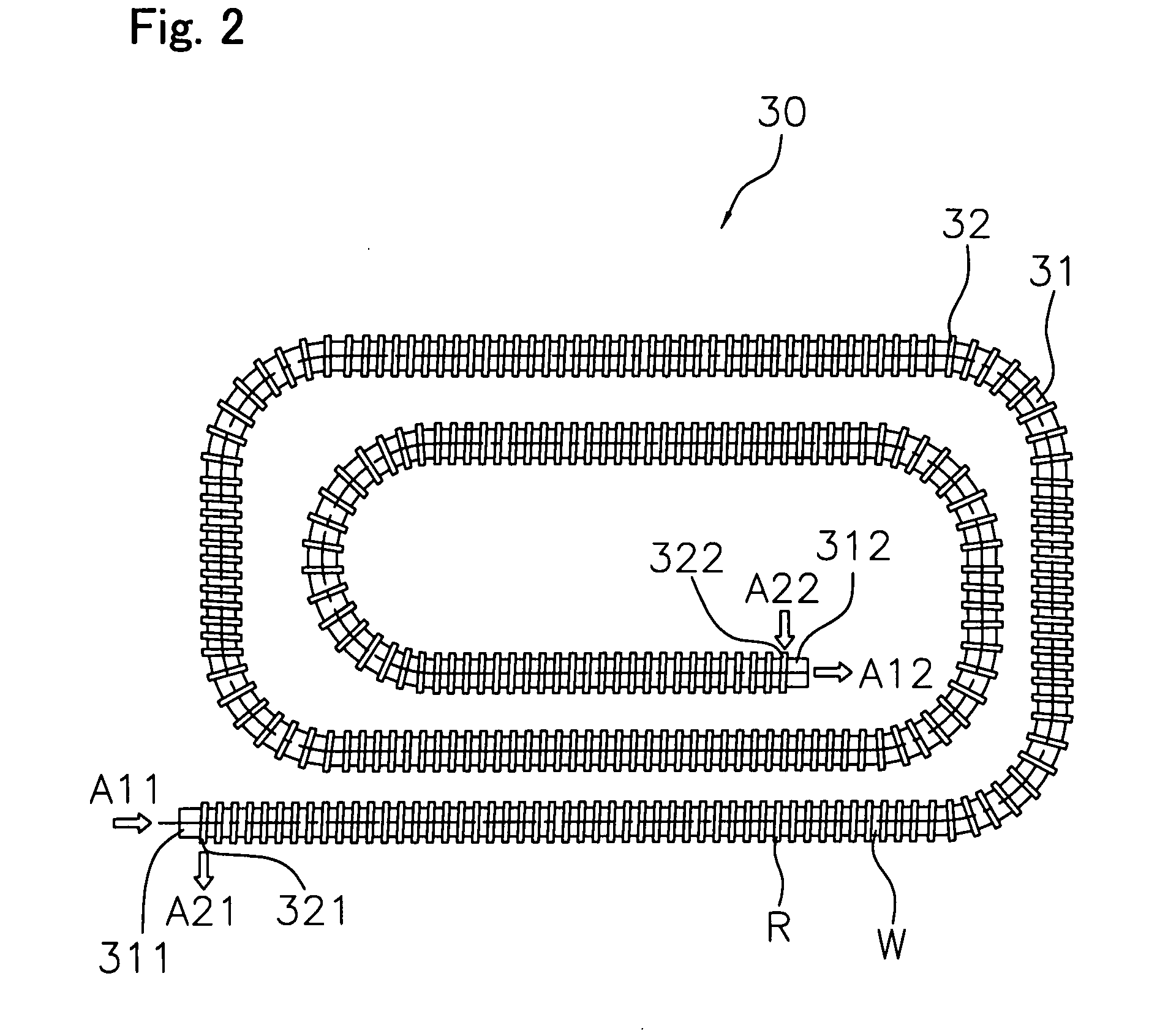Hot Water Heat Transfer Pipe
a technology of hot water and heat exchange pipe, which is applied in the direction of indirect heat exchangers, mechanical equipment, lighting and heating apparatus, etc., can solve the problem of inability to achieve efficient heat exchange, and achieve the effect of preventing a reduction in the effect of heat transfer and reducing the heat transfer
- Summary
- Abstract
- Description
- Claims
- Application Information
AI Technical Summary
Benefits of technology
Problems solved by technology
Method used
Image
Examples
experiment 1
(1) Experiment 1
[0083]FIG. 5 (a) is a cross sectional perspective view of the heat transfer pipe 31. In experiment 1, projections each having a height H1 of 1.0 mm are provided vertically symmetric on the pipe inner surface having an inner diameter D of 8.0 mm so that the pitch P in the pipe axial direction is 20 mm. FIG. 5 (b) is a cross sectional view taken along the A-A arrow in FIG. 5 (a), and FIG. 5 (c) is a cross sectional view taken along the B-B arrow in FIG. 5 (b). As can be seen from FIG. 5 (a) and FIG. 5 (b), the projections 313 are formed on the inner surface by indenting the outer surface of the heat transfer pipe. In addition, as can be seen from FIG. 5 (c), each projection 313 is formed so that its shape in the transverse sectional view is elliptical. Further, flat surfaced parts 31a not provided with projections exist on the inner surface of the heat transfer pipe 31. FIG. 6 (a) graphs, for each Reynolds number Re in the low Reynolds number section arising from the f...
experiment 2
(2) Experiment 2
[0085]To investigate the impact of the height H1 of the projections 313 on the heat transfer performance and on the pressure loss of the flow inside the pipe, experiment 2 was performed by varying the height H1 of the projections 313 provided on the pipe inner surface. FIG. 7 (a) graphs the heat transfer performance for the case in which projections having differing heights H1 are provided vertically symmetric in a heat transfer pipe having an inner diameter D of 8.0 mm so that the pitch P in the pipe axial direction is 20 mm. Further, the horizontal axis represents the value of the height H1 of the projections 313. The vertical axis represents the ratio (Nu / Nuo), which is the ratio of the Nusselt number Nu of the heat transfer pipe 31 provided with projections' 313 to the Nusselt number Nuo of the smooth heat transfer pipe not provided with projections. The solid line represents the experimental results for when the Reynolds number Re was 4,000, and the dotted line ...
experiment 3
(3) Experiment 3
[0088]In experiment 3, instead of assigning the height H1 of the projections 313, as is, as an index, the relative roughness (H1 / D) serves as the index. To investigate the impact of this relative roughness (H1 / D) on the heat transfer performance and on the pressure loss of the flow inside the pipe, this experiment was performed by varying the relative roughness (H1 / D). FIG. 8 (a) graphs the heat transfer performance by varying the relative roughness (H1 / D) in the states when the Reynolds number Re was 2,000 and 4,000, and for the case in which a smooth pipe not provided with projections was employed. Herein, the horizontal axis represents the value of the relative roughness (H1 / D). The vertical axis represents the ratio (Nu / Nuo), which is the ratio of the Nusselt number Nu of the heat transfer pipe 31 provided with projections 313 to the Nusselt number Nuo of the smooth heat transfer pipe not provided with projections. As can be seen from FIG. 8 (a), the larger the v...
PUM
 Login to View More
Login to View More Abstract
Description
Claims
Application Information
 Login to View More
Login to View More - R&D
- Intellectual Property
- Life Sciences
- Materials
- Tech Scout
- Unparalleled Data Quality
- Higher Quality Content
- 60% Fewer Hallucinations
Browse by: Latest US Patents, China's latest patents, Technical Efficacy Thesaurus, Application Domain, Technology Topic, Popular Technical Reports.
© 2025 PatSnap. All rights reserved.Legal|Privacy policy|Modern Slavery Act Transparency Statement|Sitemap|About US| Contact US: help@patsnap.com



